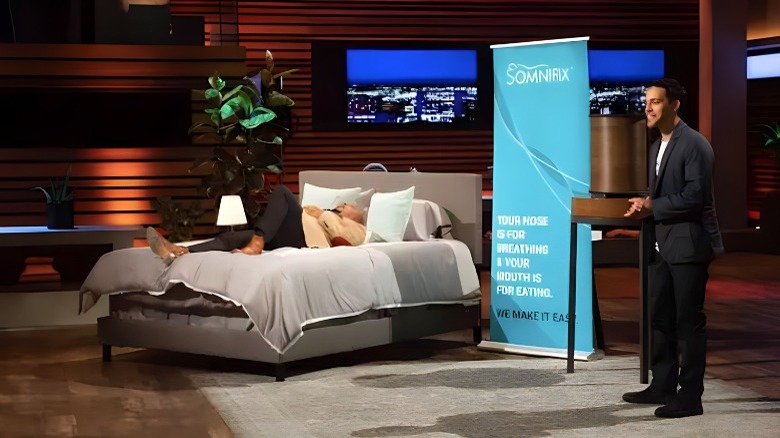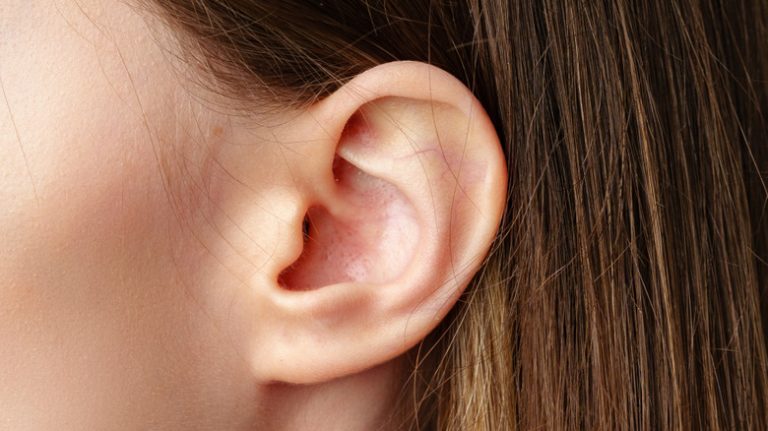
Dr. Andre Michalak developed SomniFix mouth strips when he began snoring due to sleep apnea. SomniFix is a small piece of tape that covers your mouth to encourage nasal breathing. It has a small vent for minimal mouth breathing. The product claims that nose breathing can enhance sleep quality, reduce snoring, and increase the effectiveness of your CPAP machine.
The Sleep Foundation mentions that the recyclable, single-use SomniFix strips can replace older methods of training to breathe through the nose by taping the mouth. SomniFix is easier and less painful to remove than traditional mouth taping methods. Although SomniFix is safe for most people, it shouldn’t be used by individuals with low blood pressure, a cold or sinus infection, or a body mass index (BMI) over 35. It’s also not recommended for children or those who have consumed alcohol or sedatives.
Fans of “Shark Tank” may recognize SomniFix, as its creators sought investment from the Sharks during a season 10 episode. To find out what has happened to the product since then, read on.
The Shark Tank pitch

According to the official “Shark Tank” blog, Michalak and his son Nicholas invested $1.4 million in clinical studies for the product, achieving $350,000 in sales before Nicholas brought the product to “Shark Tank” for assistance.
During season 10 of Shark Tank, Nicholas began his pitch by discussing the importance of quality sleep and how mouth breathing can disrupt it. He invited Daymond John to try the product and then asked the Sharks for a $500,000 investment for a 10% equity stake. John acknowledged the product’s merits but declined to invest, and Lori Greiner expressed doubts about its market potential. Barbara Corcoran voiced concerns about SomniFix’s viability, noting Michalak’s high expenditure to launch the product (via CNBC). Kevin O’Leary also declined.
Mark Cuban was impressed by Michalak’s investment in clinical studies prior to marketing SomniFix. Cuban suggested that the product could benefit sports performance and offered $500,000 for a 20% stake in SomniFix. Michalak countered with a $2 million post-money valuation. Although Cuban agreed to the deal on Shark Tank, he never finalized it (via Shark Tank Recap).
SomniFix is still available

You can still purchase SomniFix on its website, where it has nearly 5,000 mostly 5-star reviews. People using a CPAP machine appreciate SomniFix for allowing them to switch to a nasal mask instead of a full mask. Others value SomniFix for teaching them to breathe through their nose, preventing nighttime dry mouth. SomniFix is available as a Marketplace Seller on Walmart’s website, but you won’t find it on Amazon or CVS.
Regarding social media presence, SomniFix remains modest. It has 2,500 likes on Facebook but over 18,000 followers on LinkedIn. Posts focus on the benefits of nose breathing and sleep importance. A recent post showed tennis star Iga Swiatek preparing for the Canadian Open while playing tennis with mouth tape, though it doesn’t specify her as a SomniFix user. Since 2019, SomniFix has only three posts on X (formerly Twitter).
Nicholas Michalak is listed as the CEO of the company, though SomniFix only lists three employees on LinkedIn. Dr. Andre Michalak, the inventor, remains a doctor in the Washington, DC area and is not currently associated with the product.
Ways to treat sleep apnea and snoring

Though SomniFix reviewers appreciated the mouth tape for alleviating dry mouth, snoring, and sleep apnea, some may hesitate to sleep with tape on their mouth. If you have sleep apnea, there are alternatives to SomniFix.
According to the National Institutes of Health, sleep apnea can be managed through regular exercise, weight management, quality sleep, reduced alcohol intake, and smoking cessation. A continuous positive airway pressure (CPAP) device also enhances throat air pressure during sleep. If a CPAP device is uncomfortable, doctors may recommend oral devices to reposition the jaw or prevent the tongue from blocking the throat. Some doctors might prescribe exercises to strengthen facial muscles.
Snoring is sometimes linked to sleep apnea, but can also result from nasal congestion, according to Stanford Medicine. Decongestants and corticosteroid sprays can clear sinuses and reduce snoring. Nasal strips can open nasal passages for easier breathing. Sleeping on your side instead of your back helps prevent the tongue from blocking the throat. Raising your bed slightly, with the head 4 to 6 inches higher than the foot, may also reduce snoring.




